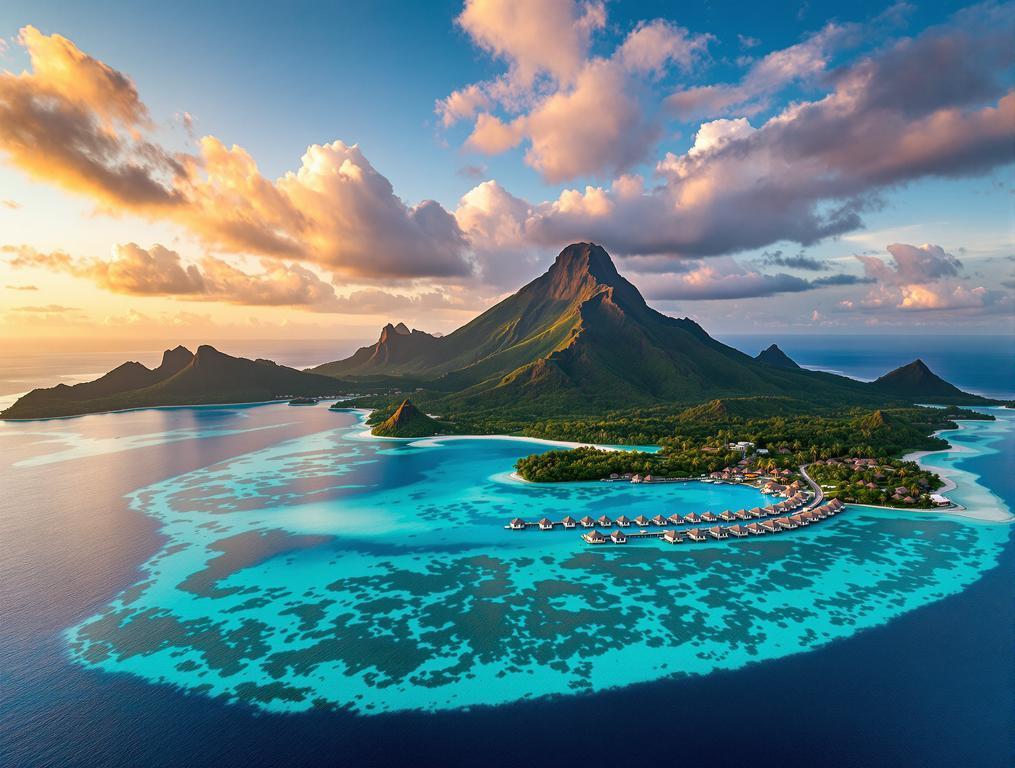The morning sun dances across Mount Otemanu’s volcanic silhouette as I step onto Bora Bora’s Motu Mute Airport. I’m immediately struck by a paradise island whose 10,000 permanent residents will host an astounding 300,000 tourists in 2025. That’s a 30:1 visitor-to-local ratio – among the highest in the world. Standing on this former WWII airstrip, I can already sense how this French Polynesian jewel is positioning itself as 2025’s sustainable luxury leader while balancing a tourism surge against its pristine ecosystem.
Bora Bora’s 30:1 Tourist-to-Resident Ratio Redefines Sustainable Luxury
As I navigate a traditional outrigger canoe across the lagoon, my local guide explains how Bora Bora’s tourism has evolved. The island saw 263,766 visitors in 2024, a 6.9% increase from the previous year, with predictions showing 2025 will cross the 300,000 threshold.
“We’re not just selling paradise anymore,” Rainui Besinau, Bora Bora Tourism Chair, tells me over fresh poisson cru at a beachside café. “We’re pioneering sustainable luxury tourism that preserves our volcanic landscapes and coral ecosystems.”
This balancing act is remarkable. While some Maldives islands have pioneered non-resort tourism models, Bora Bora’s approach leverages its unique volcanic topography. Unlike flat atolls, Bora Bora’s 727-meter Mount Otemanu creates diverse ecosystems from rainforest to reef.
Tourism accounts for 18% of French Polynesia’s employment, with each visitor spending approximately 380,000 XPF ($3,700 USD) per stay, excluding flights. The 2021-2025 tourism strategy focuses on quality over quantity, limiting certain areas to prevent overcrowding.
Why Volcanic Islands Trump Flat Atolls for 2025’s Eco-Conscious Travelers
While kayaking the clear waters near Four Seasons Resort, I spot eagle rays gliding beneath my paddle. This vertical diversity – from mountain peaks to coral gardens – gives Bora Bora a competitive edge for 2025’s eco-tourism boom.
“I visited the Maldives last year and Hawaii before that. But only here can I hike volcanic trails in the morning and snorkel with manta rays by afternoon – all while my resort uses solar power and reef-safe practices.”
Just as extreme environments can create unexpected wellness benefits, Bora Bora’s dramatic landscape fosters unique sustainability innovations. The island’s resorts have pioneered glass-floor bungalows that encourage marine appreciation without disturbance – a model now being adopted worldwide.
While the Maldives consists of flat coral atolls averaging 1-2 meters above sea level, Bora Bora’s volcanic peaks create natural rainwater collection systems and diverse microclimates. This allows for vertically integrated eco-tourism impossible on flat islands.
The island’s two distinct lagoon channels – deep Bora Bora Channel and shallow Papeete Channel – create varied marine environments supporting different activities. Luxury resorts now limit sunscreen use near coral gardens and organize weekly beach cleanups with guests.
How to Experience Authentic Polynesian Culture During the Optimal Dry Season
Bora Bora’s optimal visiting window is June through October – the dry season when visibility for marine life viewing peaks. I’m visiting in July, when waters are clearest and hiking conditions ideal.
For authentic experiences, visit Anau and Fa’anui villages where locals still practice traditional ahima’a earth oven cooking. Similar to how Hawaii preserves its cultural heritage sites, these communities maintain Polynesian traditions despite tourism pressures.
Avoid Matira Beach during cruise ship days (Tuesdays and Thursdays typically), when day-trippers arrive en masse. Instead, hire a local guide for Mount Pahia hikes – the less-visited 658-meter peak offering comparable views to Otemanu with fewer crowds.
Learn the phrase “Mauruuru roa” (thank you very much) – it’s small cultural gestures that separate thoughtful travelers from casual tourists. The Heiva Festival in July-August offers traditional dance, music and sports competitions rarely featured in travel guides.
As my outrigger returns to shore, the setting sun transforms Mount Otemanu into a silhouette against watercolor skies. I’m struck by how this island balances its volcanic heart, coral soul, and tourism future. In 2025, when sustainable luxury tops travel trends, Bora Bora won’t just be another paradise postcard – it will be leading the conversation on how breathtaking destinations can thrive while preserving what makes them special. As my 7-year-old daughter Emma would say about her sandcastles: sometimes the most beautiful things require the most careful protection.
